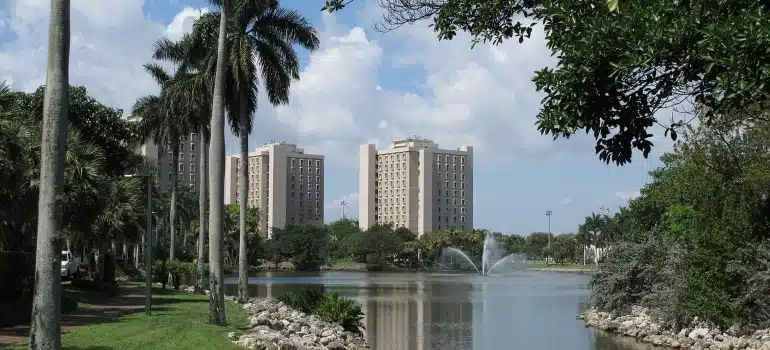Best colleges in Miami
Miami is more than a tourist destination. For thousands of students every year, it’s also where serious academic and career plans take shape. The city offers access to respected colleges, growing industries, and strong internship networks. Families and students relocating for college often look for programs that balance academic quality, affordability, and long-term opportunity. In fact, Miami provides all three across its public and private institutions. This Pro Movers Miami guide highlights the best colleges in Miami and its metro area and shares useful tips on housing, tuition, career services, and student life. So whether you’re aiming for a four-year university or a transfer-friendly college, Miami has a place to launch your next step.
Overview of Colleges in the Miami Metro Area
Miami’s higher education options include large public universities, small private colleges, art schools, and two-year institutions. Consequently, the region supports students with different goals, from research and medical training to creative careers and trades.
Here is a list of universities and the best colleges in Miami and metro area:
- University of Miami (UM) – Private, research-focused, strong in business, law, marine science, and health
- Florida International University (FIU) – Public, large enrollment, known for engineering, hospitality, and international business
- Miami Dade College (MDC) – Public, two-year with bachelor’s options; affordable and transfer-friendly
- Nova Southeastern University (NSU) – Private, based in Davie, strong in health sciences, law, and education
- Barry University – Private Catholic school focused on nursing, education, and social work
- St. Thomas University – Private Catholic university with law, business, and liberal arts programs
- Florida Memorial University – Private HBCU; strong in education, STEM, and aviation
- Miami International University of Art & Design – Private school focused on creative fields like media, design, and fashion
- Carlos Albizu University – Graduate-focused; known for psychology and behavioral health
- Miami Ad School – Offers programs in copywriting, graphic design, and creative strategy
These schools offer different academic tracks, admissions standards, and tuition costs. Hence, choosing the right one depends on what the student wants to study, how much they can afford, and how they plan to live in the city.

Top Four-Year Colleges and Universities
If you’re planning to earn a four-year degree in Miami, a few schools clearly stand out. These colleges offer strong academics, good graduation rates, and genuine opportunities for success after graduation. You’ll find respected programs in fields like business, engineering, healthcare, and law.
Many also offer honors options, scholarships, and access to internships that can give you a head start. The schools listed below are well-regarded for a reason; they combine quality teaching with real-world results.
1. University of Miami (UM)
The University of Miami is a top private research university in Coral Gables. It’s selective, accepting only about 19% of applicants. The middle 50% SAT range is 1330–1470, and ACT scores range from 30–33. As a result, most incoming students hold a GPA of 3.8 or higher.
UM offers strong programs in business, pre-law, medicine, marine science, and music. Students have access to over 180 majors and active research centers across disciplines. The school also provides generous merit-based scholarships, including awards like the President’s Scholarship ($28,000/year) and the Stamps Scholarship (full cost of attendance).
The campus is well-connected through the Metrorail and school shuttles. Popular neighborhoods for off-campus housing include Coral Gables, South Miami, and Coconut Grove. Local movers in Coral Gables are often a great choice for students looking to relocate to these areas due to their familiarity with the local streets and apartment complexes.
Rents range from $800 for shared units to over $3,000 for one-bedroom apartments. On-campus housing is available but fills up fast. UM students benefit from strong alumni connections, especially in healthcare, real estate, and finance. It’s a strong choice for academically driven students seeking an experience of studying at one of the best colleges in Miami.
2. Florida International University (FIU)
FIU is a major public university with campuses in West Miami and Biscayne Bay. With over 50,000 students, it offers a wide range of undergraduate and graduate degrees.
Top programs include international business, hospitality, engineering, and public administration. FIU has strong partnerships in Latin America and supports bilingual learning. Many classes are offered online or in hybrid formats, which helps working students or those commuting from home.
In-state tuition is significantly lower than private schools, and the university offers merit aid and scholarships. For housing, FIU operates residence halls on both campuses and offers summer intern housing for non-students working in Miami.
Additionally, the school ranks as an R1 research university and has expanded its career services. FIU uses platforms like Handshake for internships and jobs and offers stipends for students completing international placements. Hence, for students looking for affordability, academic range, and flexibility, FIU is a strong contender.
3. Nova Southeastern University (NSU)
Located in Davie, about 30 minutes from central Miami, NSU is a private university best known for its graduate and health sciences programs.
Colleges within NSU include dental medicine, optometry, pharmacy, law, and psychology. Undergraduates can apply to dual admission programs that reserve their seats in graduate school early, giving them a head start.
Class sizes are small, and the faculty offers hands-on support. Tuition is on the higher side, but the university’s specialized offerings make it worthwhile for students committed to healthcare or legal careers. The campus is suburban and quieter than Miami’s core, which may appeal to students looking for a more structured environment.
Besides, internships and research opportunities are built into many degree paths. Students also have access to career coaching, workshops, and a growing network of local healthcare employers.

4. Miami Dade College (MDC)
MDC is Florida’s largest among the best colleges in Miami, with eight campuses and over 100,000 students. It’s known for its open admissions policy, affordable tuition, and strong transfer agreements with larger universities.
Furthermore, students can earn associate degrees or enroll in select bachelor’s programs in nursing, education, public safety, and IT. Tuition is among the lowest in the region, making it a good option for families looking to reduce the overall cost of college. Flexible class schedules, evening options, and online learning support both traditional and non-traditional students.
Also, many students start at MDC and later transfer to UM or FIU to complete their degrees. Housing is not provided by the college, but many students commute from nearby neighborhoods or rent shared apartments. Some students transfer in from other cities and use long-distance movers in Florida to help them settle in.
MDC also offers career services, resume help, and employer events. Also, MDC works best for students starting their college journey, especially those who want to save money or explore academic interests before transferring.
Financial Aid: Making College Affordably Yours
Paying for college is one of the biggest concerns for students and their families. In Miami, tuition rates vary widely between public and private schools, but financial aid can make a big difference. The good news is that most colleges here offer need-based aid, merit scholarships, and state-supported funding.
Some schools even commit to covering full demonstrated financial need. To make smart choices, it’s important to understand what each college offers and how to apply early. Here’s what to expect from the financial aid process at Miami’s top colleges.
University of Miami (UM)
UM commits to meeting 100% of the demonstrated financial need for admitted undergraduates. Applicants must submit their FAFSA and CSS Profile by the stated deadlines. Merit-based scholarships, such as the President’s ($28K/year) and Stamps full-ride, reward academic excellence. FAFSA changes for 2025–26 require filing as early as October 1, 2024, with a federal deadline of June 30, 2026.
Florida International University (FIU)
FIU offers a mix of need-based aid, merit scholarships, and state funding (e.g., Bright Futures). The university also supports students studying abroad with stipends ($2K–$5K) and an international internship fund ($20K annually) for business majors.
Miami Dade College (MDC)
MDC has the lowest tuition in Miami-Dade County and supports students via state scholarships, federal aid, and work-study programs, ideal for budget-conscious families. Generous transfer support means students can redirect savings to a four-year school later.
Career Support & Internships: Launching Professional Beginnings
Getting a degree is important, but what happens after graduation matters just as much. That’s why it’s worth looking at how well each school helps students connect with jobs, internships, and career development. So, here’s how the most recognized schools help their students get a head start.
FIU Career Services
FIU’s College of Arts & Sciences and College of Business have robust career centers. Students use Handshake to find internships and job listings. The Humanities Edge program places students in paid internships at places like PAMM and HistoryMiami.
Business majors can also earn academic credit through internships, whether paid or unpaid. A major perk: business students may access a $20,000 fund per year for overseas internships, plus individual stipends. Students pursuing international placements also rely on white glove storage for belongings or equipment they won’t need while away.
University of Miami
UM leverages its Herbert Business School, medical, law, and marine programs to connect students with internships across finance, healthcare, government, and research. Accordingly, career services include alumni mentoring, resume clinics, and on-campus recruiting.
Nova Southeastern University & Miami Dade College
Both schools feature job placement support. NSU has a strong career coaching network connecting students to healthcare and legal employers. Additionally, MDC offers career fairs and employer partnerships to ease transitions to four-year programs or local careers.

Choosing the Right Fit: What Really Matters
Picking among the best colleges in Miami is more than checking rankings. Here’s what matters most:
- Strength in your field – Choose schools with recognized programs in your major (e.g., UM for health sciences, FIU for engineering, MDC for IT).
- Size & style – Large public (FIU) vs. small private (UM, NSU)—consider class size and personalized attention.
- Campus and commute – Do you want a walkable campus (UM, NSU) or a commuter-friendly system (MDC, FIU)? Additionally, assess transit and off-campus options.
- Cost – Calculate total yearly cost: tuition, housing, food, transport. Students and families relocating for college almost always budget their move. Comparing moving quotes in Miami is a smart and common step.
- Career path readiness – Explore internship availability, stipends, alumni networks, but also professional support services.
- Campus culture – Visit campuses, attend info sessions, and chat with current students. Understand student life, clubs, and community.
Many students find that trusting their instincts works best. After all, if it doesn’t go as planned, transferring is always an option.
Smart steps to take before and after you apply
Planning ahead can save you time, money, and stress. Whether you’re just starting to look at colleges or already filling out applications, these tips can help you stay on track. They’re based on what Miami-area colleges recommend and what students say worked best for them:
- Complete FAFSA early (Oct 1, 2024) to secure aid options that run out quickly.
- Apply for state scholarships like Florida Bright Futures. Coverage ranges from partial to full tuition.
- Investigate internship support early. Although FIU offers funds, UM has strong career ties.
- Weigh the cost by year. MDC is a high-value, low-cost start, while UM can be affordable with aid.
- Visit campuses; next, attend in-person or virtual events, and assess lifestyle, commute, and campus feel.
- Create a checklist with major, cost, aid, class size, housing options, and support services.
- Identify backup plans; start at MDC or FIU, transfer later, or pursue part-time online classes alongside work.
Use this checklist as a starting point, but adjust it based on your own goals and timeline. The earlier you prepare, the easier it becomes to find a college that fits your needs, both academically and financially.

FAQ about the best colleges in Miami
If you’re getting ready to move to Miami for college, you’re probably sorting through a lot of details. Families and students often ask the same key questions during the process, from deadlines and housing to how competitive the best colleges in Miami are. We’ve gathered some of the most common questions below to help clear things up and guide your next steps.
Q: What’s the FAFSA deadline?
A: Federal FAFSA for 2025–26 launches December 1, 2024; the federal deadline is June 30, 2026. Individual colleges may set earlier deadlines, but UM and FIU recommend filing by spring 2025.
Q: What aid does FIU offer?
A: Merit scholarships, Bright Futures, need-based aid, work-study, travel stipends ($2K–$5K), and also a $20K fund for business-school international interns.
Q: Are internships paid?
A: Depends on the program. Business and humanities internships may offer stipends or credit, while STEM/engineering positions are often paid. Career offices at FIU and UM help with placement.
Q: How do I know which college suits me?
A: Ask them, what’s your major strength? preferred class size? budget? social environment? Start by visiting schools and talking with advisors. You can always transfer later.
Q: I’m unsure about on-campus housing.
A: Rental prices near UM run from $800 (shared) to $3,000+ (1‑bedroom). FIU offers residence halls and summer internship housing. MDC is commuter-friendly, so plan for off-campus rent.
Q: How competitive is UM as one of the best colleges in Miami?
A: The University of Miami is competitive, admitting about 18–19% of applicants. Most accepted students score between 1330 and 1470 on the SAT or 30 to 33 on the ACT. Also, the average high school GPA is around 3.8.
